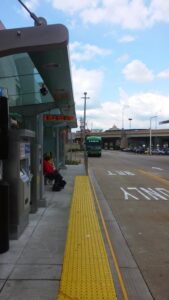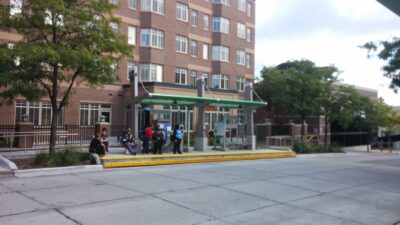
Here comes BRT! Silver Line’s stations include “blue light” emergency phone kiosks, fare machines, and digital signs showing when the next vehicle arrives.
The Rapid cut the ribbon on their Silver Line, Michigan’s first BRT system, a few weeks ago, connecting Grand Rapids, Wyoming, and Kentwood along 9.6 miles of Division Avenue. BRT, or bus rapid transit, tries to provide the benefits of a light rail system, like travel speed, reliability, and ease of use, but with tires and pavement instead of the upfront costs of laying rail; the metro Detroit RTA, Lansing’s CATA system, and the Ann Arbor Area Transit Authority (AAATA) are all exploring BRT for their high-demand routes. Similar to a rail system, these benefits of BRT should support higher ridership, leading to residents and businesses wanting to be near the stations and driving real estate development in these areas.
Last week, I had the opportunity to catch a ride on the Silver Line and get an initial idea of how well it delivers on the promise. Since I had to be downtown both before and after my research ride, I just rode out from the central station for a while before getting off and crossing the street to come back, but the impressions of riders who were actually using the BRT to go somewhere were overwhelmingly positive.
Typical bus routes are slower than car travel, because they not only experience the same traffic and red lights, but also have to stop every few blocks for passengers. The Silver Line attempts to cut down all of these delays:
- Dedicated lanes marked “BRT ONLY” for about 2/3 of the route mean that the BRT isn’t competing with traffic-in some cases we zipped by lines of cars, while the parts of the route we shared with traffic were notably slower
- Signal priority means that the traffic signals try to give the BRT a green whenever possible, shortening the time it spends stopped for red lights.
- The stations are bigger structures, and average about a half mile apart (closer together downtown), instead of bus stop signs every 3-4 blocks, reducing the number of stops.
- Pre-boarding fare payment has riders buying a ticket before they get on the vehicle, so nobody’s fumbling for change at the door and holding up the bus.
The riders I talked to said it was working, even though many cars hadn’t yet learned they were supposed to stay out of the BRT lanes, and even though the fare machines at the stations had some learning curve: the BRT ran faster, came more frequently, and was altogether a more pleasant experience than riding the “regular” bus. As a result, the BRT had most seats full on both my ride out and back, at 3:30 on a Wednesday afternoon. Obviously, Month 1 is very early for trying to measure either ridership or economic development impacts, but I also talked to a developer looking at a few sites along the route for mixed-use, residential + retail projects.
Grand Rapids has set the bar for the other Michigan regions considering BRT, and
there is also room to improve:
- For now at least, the Silver Line departs every 10 minutes during peak hours, but only every 20 minutes mid-day, which falls short of “so often you don’t need a schedule”-the best case for calling a transit line truly “convenient” (and a goal the BRT can grow towards).
- The vehicles have somewhat larger front and rear doors for faster boarding, but otherwise seem nearly the same as typical buses. By comparison, Cleveland’s HealthLine BRT has extra-long buses with no stairs to reach the rear seats, and lets riders bring bicycles on board (avoiding delays from loading them on the front racks).
- The areas where the BRT shares a lane with cars are noticeably slower than the dedicated lanes, limiting the speed benefit.
Coincidentally, the Detroit RTA board approved the “locally preferred alternative” (LPA) for a Woodward BRT system while I was riding the Silver Line. The LPA provides the broad strokes of a transit system, allowing the RTA to dive into the details of engineering and service design. With calls for Woodward to be the first “Gold Standard” BRT system in the United States, the RTA can learn from Grand Rapids’ very good system as they work towards a final design.
